In today’s edition of Legend Has It, we celebrate the 50th anniversary of iconic aquatic horror film Jaws and its three sequels. Released back on June 20th, 1975, the original three-time Oscar-winning Jaws film ushered in the summer blockbuster, a global phenomenon that is still entertaining audiences today.
Fifty years ago this sunny, beach-worthy, splash-friendly June, a small director had a HUGE breakout hit. Enter 28-year-old New Hollywood director Steven Spielberg and his iconic aquatic horror film Jaws. Since its auspicious release date on June 20th, 1975, this movie, and its three sequels of Jaws 2 (1978), Jaws 3-D (1983), and Jaws: The Revenge (1987), have been terrorizing audiences in the most primal, survivalist ways.
For anyone unbelievably not in the know (as this film franchise enjoyed massive success), imagine one mammoth, blood-thirsty great white shark who just can’t get enough of human flesh. Truly frightening. That’s what each of these movies is about. It’s as basic as that. And this shark-villain seems to like the human flesh from a quaint, upscale New England resort called Amity Island the best, though the sharks of the 1983 and 1987 films apparently prefer the warmer waters of Florida and the Bahamas respectively. (Where’s that higher-protection sunscreen?)
Nominated for four Oscars (Best Film Editing, Best Original Score, Best Sound, and Best Picture) and winning three (all but Best Picture), and becoming the first film to earn more than $100 million (making it the highest grossing movie up until that time), the original Jaws film enjoyed both critical and commercial success the likes of which have rarely been seen since. What’s more, its perfect release date of June 20th (the day before the summer solstice), helped make the summery July 4th tale a true summer blockbuster, and helped lay the foundation for future summer movie franchises. Cue Star Wars, Indiana Jones, and more.
And while Spielberg was not involved with any of Jaws’ three sequels, and while none of the sequels came close to achieving the magnitude of success of the original, all movies in this horror franchise are worth celebrating and dissecting this highly-awaited 50th anniversary year. From plot, to casting, setting, special effects, and more, the Jaws films are worthy of that deep, scary, scuba dive. So, check your streaming subs. Check your local theaters and bookstores. The sparkly anniversary fun is happening all around the world this summer. Let’s dive in!
The Franchise’s Brilliance
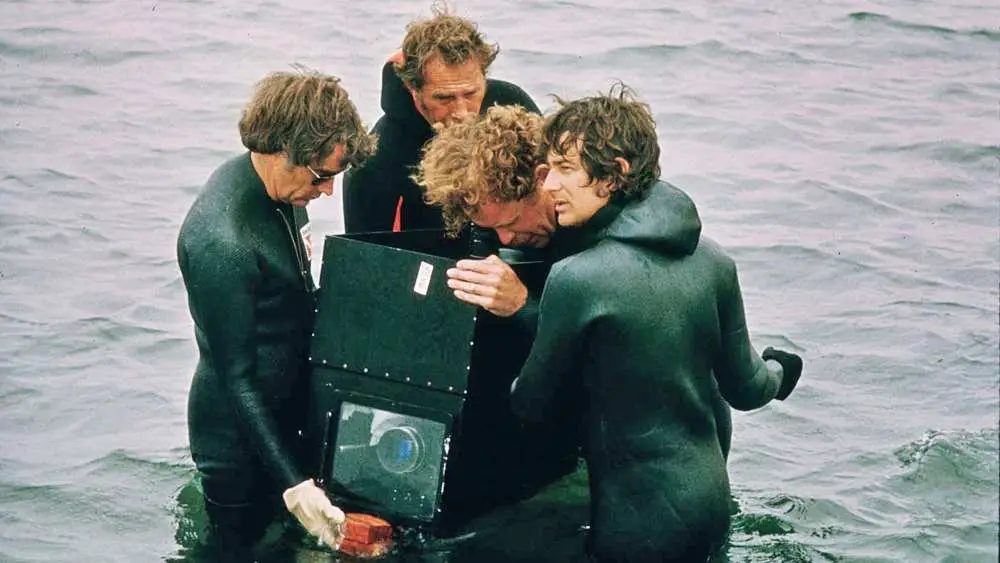
The Jaws series is revered for a myriad of things – its “on-location” shoots, panic-inducing Oscar-winning theme song, core family of cursed characters (i.e., The Brodys), and one “high-concept” of man vs. monster. The first two films are a prime example of wonderfully gritty “1970s realism” filmmaking, with Martha’s Vineyard, Massachusetts, serving as fictitious New England resort Amity Island. Noteworthy, the original Jaws was the first major film to be shot on the ocean. Its three sequels would continue this “authentic” vibe with Jaws 2 also being filmed on location in Martha’s Vineyard, Massachusetts, and other locales, and then Jaws 3-D and Jaws: The Revenge being shot primarily in Florida and the Bahamas respectively.
Filming on-location notoriously caused issues for Spielberg. Large ships sailed into his long shots, thus requiring him to wait for their gracious exit. Additionally, the ocean wreaked havoc. Cue the famous sinking Orca II that was pulled too fast by the crew’s speedboat, causing the ocean to engulf and flood it. Hollywood legend has it that all the crew begged, “Save the camera!” The boat might be goin’ down, but more important than that? All that precious scene footage!
But what are some of the lesser-known deep-sea pearls from the Jaws films? Here are a few. In the first film, Spielberg utilizes a Hitchcock technique that the iconic Master of Suspense director Alfred Hitchcock uses in Vertigo (1958). It’s when Chief Brody (actor Roy Scheider), sitting on the beach, witnesses the Kintner boy’s shark attack out in the ocean. Outside of Scheider delivering a helluva riveting facial expression, Spielberg pulls a Hitchcock, where he zooms in with his camera on Scheider while, at the same time, zooms out with his lens. It’s called a dolly zoom. Excellent at conveying this character’s panic and fear? Absolutely.
Jaws’ Hidden Details
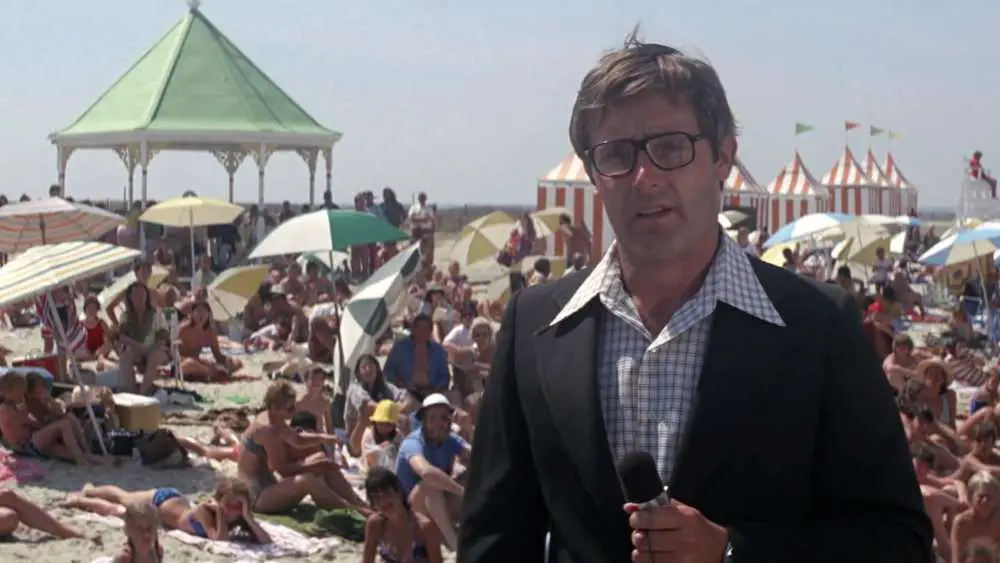
The original Jaws also boasts a cameo by Jaws’ best-selling author Peter Benchley (the mastermind behind all the Jaws aquatic horror dorsal-fin mayhem). He plays a TV reporter in a beach scene, surrounded by sunbathers and a helicopter. Jaws’ co-screenwriter, Carl Gottlieb, also makes a cameo. He plays the newspaper editor directing a photo shoot.
Switching gears, Jaws 2 (lauded as the franchise’s best sequel), has a small scene which many of the filmmakers wished wasn’t cut. It’s the helicopter scene where, if kept to its original length, would’ve allowed the audience to see the helicopter pilot’s gruesome consumption by the shark. Re-watch this scene and imagine a teeny bit more. Bone-chilling. Terrifying.
As for Cable Junction, the miniscule outlying island where the teenagers have an opportunity to escape the shark and get on shore, this island is artificial. Filmmakers made it out of fiberglass, and it was built atop barges. However, turns out it wasn’t sturdy and sound. It kept drifting away in the Atlantic Ocean. Cast-members also stumbled due to its slipperiness. But, the final on-screen visual was a success.
For Jaws 3-D, this 3-D special effects sequel, unfortunately widely panned, still boasts the biggest shark in the four-flick series. This notorious “mother shark” clocks in at 35 feet, a whopping 10 feet longer than the others. (Would Bruce, the famous nickname of 1975’s original animatronic villain-shark, be a match for this warm-water SeaWorld doozy?) Noteworthy, though the biggest shark of the bunch, Jaws 3-D’s finale scene is often the most widely criticized finale scene of the franchise. The gargantuan shark swims toward an underwater SeaWorld amusement park control-room to terrorize the park’s employees within, but the slow-moving shark and super-fake visuals were jeer-worthy. It just wasn’t convincing. But, who knew that there was a higher quality take of this scene, unfortunately left on the cutting room floor?
For Jaws 4: The Revenge, all die-hard series fans already know about the two different finale versions. (Will Jake, played by likeable actor Mario Van Peebles, survive?) But, what about another element of the finale scene, which involves a roar? Yes, indeed, the shark-villain in installment four actually roars. Reminder, sharks do not roar. What’s more, this roar was taken from a vintage 1946 Tom and Jerry cartoon! Truly amazing. Jaws 4: The Revenge also originally had a scene where the young daughter is hypnotized, and meanders into the dangerous ocean at night. She’s prime placement for a shark-villain feast. But, this scene didn’t make the final edit.
Jaws Behind-The-Scenes

Spielberg was notoriously nervous while filming Jaws. As mentioned, it was a difficult on-location shoot, which caused filming to surpass its time and money budget. The film took five months to shoot on Martha’s Vineyard, and cost $9 million. Hollywood legend has it that Spielberg chewed his fingernails down to stubs. Watch old 1974 interviews of Spielberg. His fingernails are indeed extremely short!
Spielberg also made what could’ve been a nervous “final hour” addition to Jaws. Luckily, it was one that paid off. Sensing that audiences needed one additional huge scream, he decided to add the gruesome underwater head shot of Ben Gardner. His dead, decaying head pops out at oceanographer Hooper (played by Richard Dreyfuss), and the audience is jolted into a scream.
Staying on the actor tip, and moving onto Jaws 2, Roy Scheider, who plays hero Chief Brody in the original film, was reluctant to do the Jaws 2 sequel. He did so to finish out his contract with Universal Pictures. Winning the part of awesome police chief in the original (in which he beat out legendary actor Charlton Heston who lobbied hard for the part), Scheider was nonetheless a valuable part of the sequel’s success.
Though he had creative differences and sparring with director Jeannot Szwarc (some episodes described as being quite volatile), Scheider delivered a fine performance. He made the sequel’s infamous tagline, “Just when you thought it was safe to go back in the water” into a “No worries because Chief Brody will electrocute that shark and save you” a super-plausible outcome to reassure scared audiences everywhere.
But turns out the cast would need some reassuring, too. While filming Jaws 2, a real hammerhead shark harassed them during one scene as it swam through the ocean. At first the filmmakers didn’t realize the cast was frightened, as they were filming a scene which required the actors to shout with fear!
The Almost Spoof-Sequel
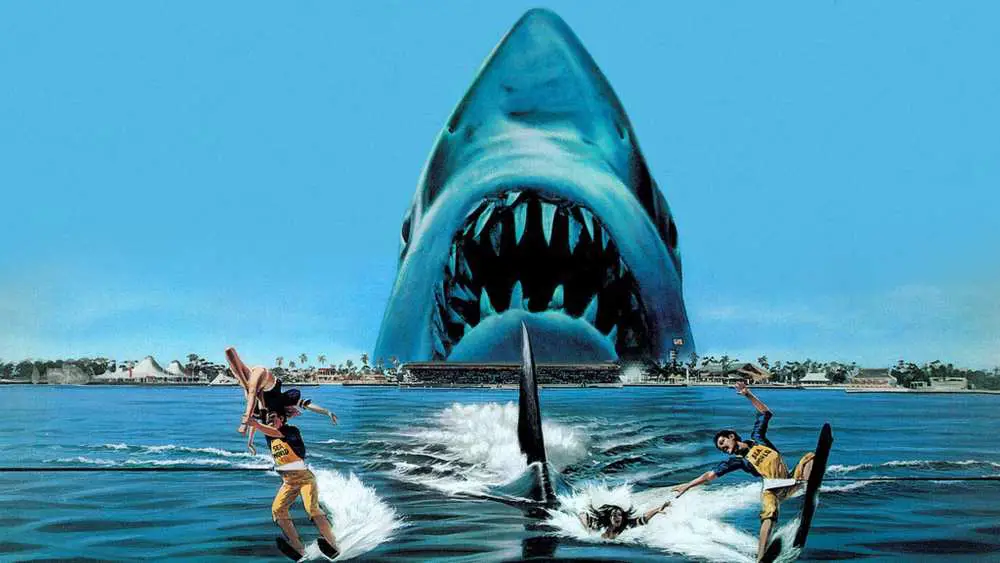
For Jaws 3-D, Spielberg balked at this sequel’s possible “spoof” vision. The title was even set to be National Lampoon’s Jaws 3, People 0. Spielberg was so incensed at the prospect of taking his horror classic into a comedic direction that he threatened to end his relationship with Universal Pictures. Although he was no longer involved in the making of the Jaws films, his opinion and rock-star director status carried huge weight. Fast-forward, and Jaws 3-D did not become a comedy.
Jaws 3-D also holds behind-the-scenes folklore with then-newcomer actor Dennis Quaid (of 1979’s critically-acclaimed Breaking Away fame and future 2004’s The Day After Tomorrow fame). Looking back, he recalled himself as using cocaine profusely throughout the film’s entire shoot.
Moving on to Jaws 4: The Revenge, the legendary Michael Caine (who won his Oscar for 1986’s Hannah and Her Sisters and NOT for Jaws 4: The Revenge) once joked of the film, and his mere seven days of filming it in the Bahamas:
Won an Oscar, built a house, and had a great holiday. Not bad for a flop movie.
He and co-star Lorraine Gary (mom Ellen Brody) even had their hair turn blue (from blue dye that was used during the finale scene which was shot in a tank). But, apparently it still wasn’t a bad day for him at the office.
The Enduring Magic of Jaws
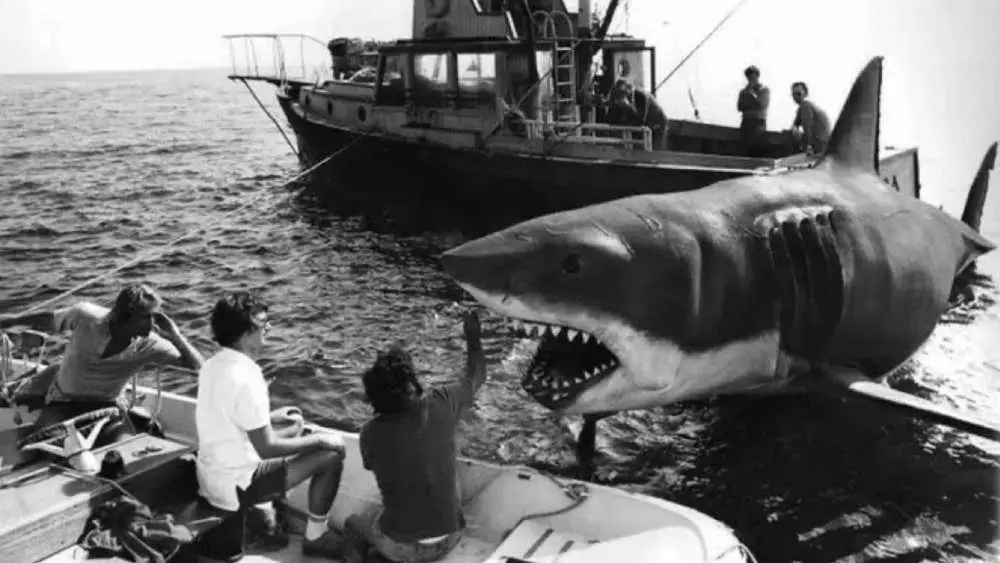
Famously plagued by an animatronic shark nicknamed Bruce who kept breaking down, Spielberg’s forced decision to shoot “around” his shark-villain character proved to be Hollywood gold. This suspense-filled terror-of-the-unseen facet to the original Jaws might be perhaps its biggest asset, alongside its masterpiece John Williams theme song, and super-cool 1970s ocean shoot.
Spielberg, and all the cast and crew involved, created a one-of-a-kind, unparalleled horror classic that has been terrifying audiences for fifty years, and inspired a whole subgenre of horror films called aquatic horror. Cue Orca (1977), Deep Blue Sea (1999), Open Water (2003), The Shallows (2016), and many more. Spielberg is still described as not being a fan of swimming in the ocean. Superstitious? Understandable. And legions of fans still report being scared of swimming in even a swimming pool, let alone the ocean. The fear runs deep.
As for Jaws’ three sequels, despite their mixed reviews, each still holds something special for someone. Jaws 2 retains the magic of Amity Island and Chief Brody (with awesome actor Roy Scheider). It also allows for the teenage horror perspective, which would become super-popular in 1980s horror film franchises like Friday the 13th and A Nightmare on Elm Street.
Then Jaws 3-D capitalizes on the 3-D special effects trend of the day, and the growing popularity of water amusement parks. Its plot switch from “open ocean” to “delightful water playground” is commendably ambitious. Cue those fancy-costumed water-skiers performing their daily show! Noteworthy, while Jaws 3-D was widely panned, it still enjoyed great box office success, proving that Jaws fans were still devotedly locked into the drama.
For Jaws 4: The Revenge, this widely panned film, responsible for the sinking of the series (pun intended), also still holds positive elements. Like Jaws 3-D, it takes us to a new location, the Bahamas. It has a new lead character, which is the mom from the first two movies. (Actress Lorraine Gary reprises her role.) It also makes ambitious use of “subliminal symbolism,” with its intriguing setting foil of Amity Island, which equals death and cold in the movie’s Christmas opening (this fourth installment is the only film to depict a non-summer timeframe), and then the Bahamas, which equals life and warmth for the remainder of the movie. Or, does it equal life and warmth?
Conclusion

The Jaws films are an indelible, treasured part of our pop culture consciousness. Cue Chief Brody’s beloved line – “You’re gonna need a bigger boat.” Blood-soaked, scream-curdling, and seasick with fear, audiences everywhere can’t get enough. The original Jaws consistently ranks in the top-tier of ‘Best of Horror’ lists, right alongside huge hitters like The Exorcist (1973). Jaws proved that horror can exist anywhere. Happy 50th Anniversary to this grand-daddy of ocean thrillers. May all our ocean frolics be safe.
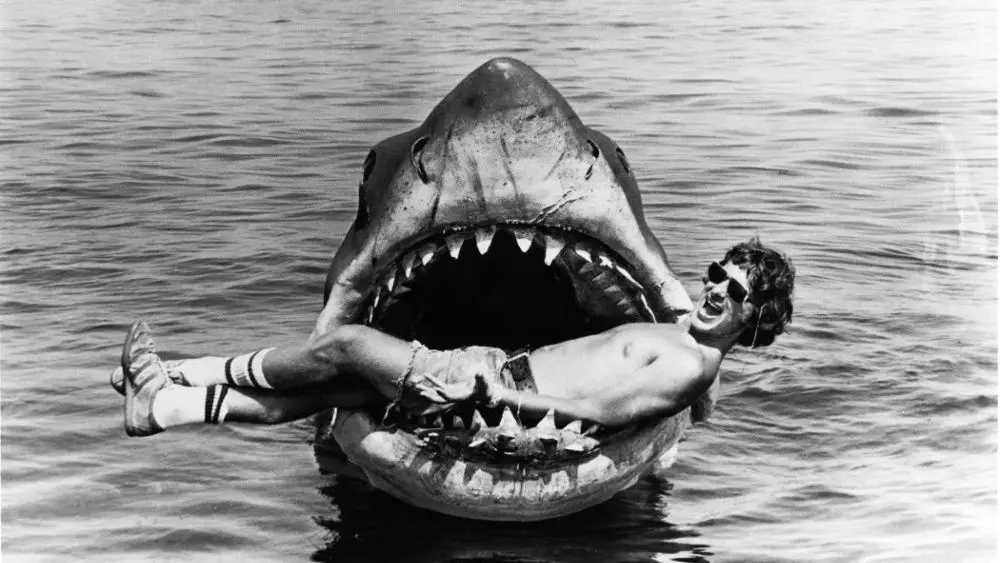

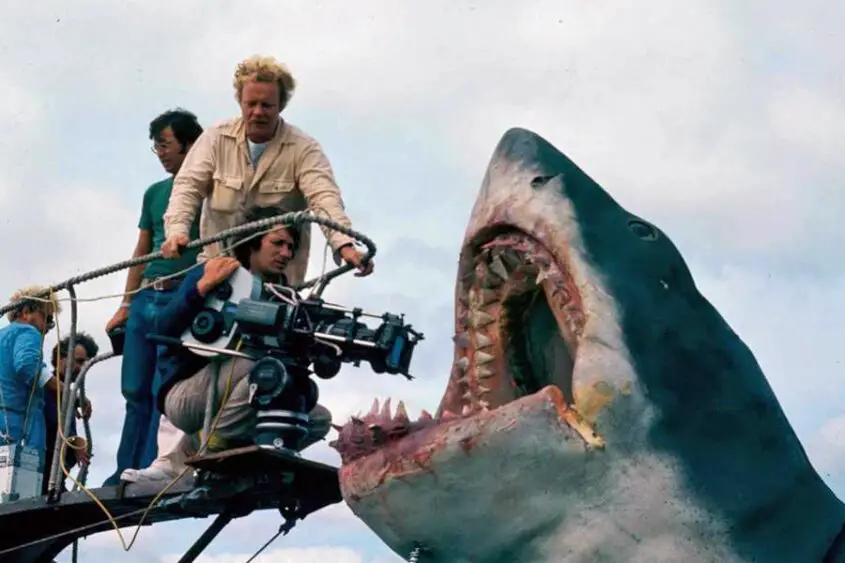
Oh wow, this is a great read!